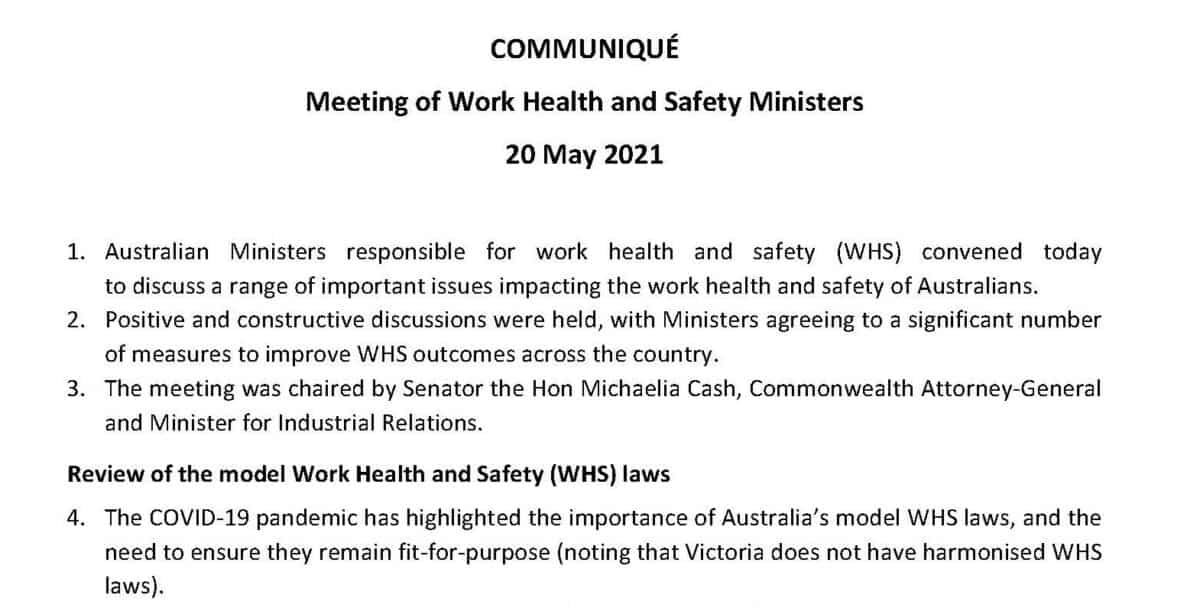This week Forbes magazine included a peculiar article about Australian occupational health and safety (OHS) headed “If You Think Managing Worker Health And Safety Is Expensive, Try An Accident“. The article written by Susan Galer includes several curious perspectives and mentions industrial manslaughter (IM).
Category: manslaughter
“as far as politically practicable”
Last week WorkSafe Victoria announced that it was prosecuting the Department of Health over breaches of its occupational health and safety (OHS) duties with the management of Victoria’s Hotel Quarantine program. There is very little information available beyond what is included in the WorkSafe media release until the filing hearing at the Magistrates’ Court on October 22 2021.
Most of the current commentary adds little and usually builds on the existing campaigns to charge (Labor) Premier Dan Andrews with Industrial Manslaughter. Still, it is worth looking at WorkSafe’s media release and the thoughts of some others.
OHS subtext in Industrial Manslaughter discussions
Senator Deborah O’Neill continued her attack on Australia’s Liberal/National party government in Senate Estimates hearing last week.
With the Work Health and Safety (WHS) ministers split on the introduction of an Industrial Manslaughter (IM) offence in the Model WHS laws, Senator Michaelia Cash, Attorney-General, Minister for Industrial Relations and chair of that WHS meeting, could have voted in favour of these IM changes but declined. O’Neill saw this as a political weakness and challenged Senator Cash to justify her decision. The justifications, with a hint of arse-covering, were morally weak but legally sufficient. At one point, Senator Cash said:
“… a fundamental principle of work health and safety regulation in Australia, as you would be aware, is that liability should focus on risk, not outcome, because the evidence shows that when you focus on risk, as opposed to outcome—and the outcome that you are referring to here is a terrible outcome: a death in a workplace—it’s been proven to actually improve health and safety in workplaces.”
Hansard, June 2, 2021, page 8
Industrial Manslaughter laws are not quite dead
The Hansard of June 1, 2021, Senate Estimates Hearings provided some nice background to the May 20 meeting of the Work Health and Safety (WHS) Ministers at which a national Industrial Manslaughter law was dismissed. Again, the politics of occupational health and safety (OHS) were on clear display.
Cause is not the same as Correlation
Politicians and executives love to claim a cause when there is only a correlation. This was displayed recently in Australian Senate Hearings on the issue of occupational health and safety (OHS) and Industrial Manslaughter (IM).
Wiktionary defines Cause as:
The source of, or reason for, an event or action; that which produces or effects a result.
And Correlation as
A reciprocal, parallel or complementary relationship between two or more comparable objects.
The conflation of these two very different relations has been a serious drag on OHS progress in practice and policy.
Industrial Manslaughter or Category 1. Which prevents harm more effectively?
The Communique issued after the May 20, 2021 meeting of the Work Health and Safety (WHS) Ministers says that Australia is not likely to apply an Industrial Manslaughter law nationally:
“While the Northern Territory, Queensland, Western Australia, the Australian Capital Territory and Victoria provided their support for an industrial manslaughter offence, the recommendation did not receive the required majority.”
Some people think that this is no real failure as the Communique also includes “defacto ‘industrial manslaughter’ laws”. Here is the quote that supports that position:
Industrial Manslaughter presents an empty hook
New South Wales’ Opposition Minister for Industrial Relations, Adam Searle, spoke recently in support of the introduction of Industrial Manslaughter (IM) laws. In Parliament on May 5 2021, he said
“… legislation is required to enable the prosecution of industrial manslaughter and to fundamentally change the approach across industry in order to raise the standard and embed a culture of workplace safety of a much higher and more stringent nature. We need a culture that supports workplace safety in our State, not a culture, as I indicated before, that allows and encourages the cutting of corners and the fostering of unsafe workplaces…..
page 43, Hansard,
Legislation can achieve many things but not by itself, and that reality often makes such penalties like Industrial Manslaughter little more than symbolic.






